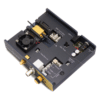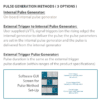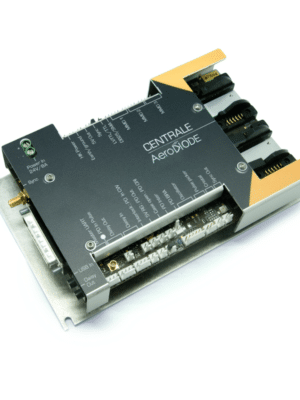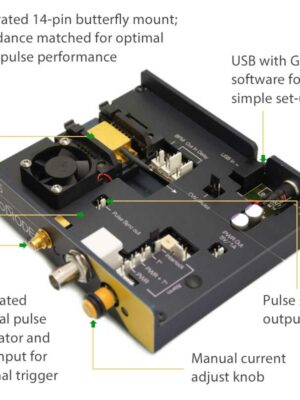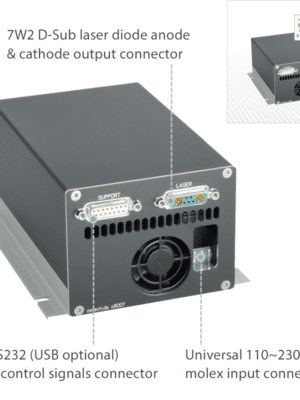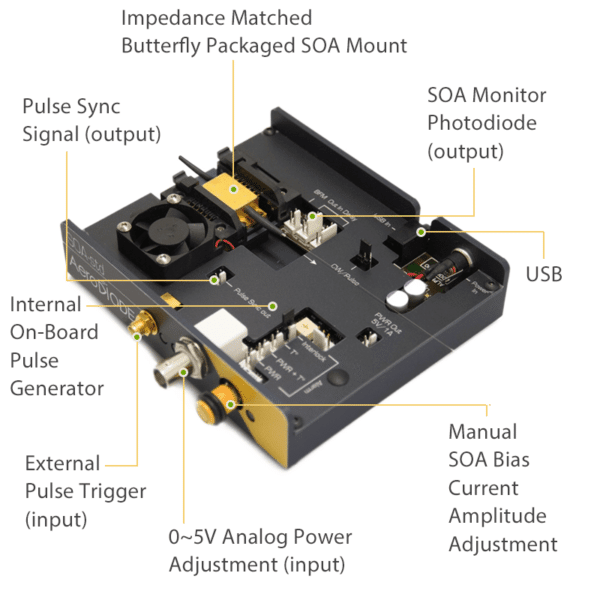
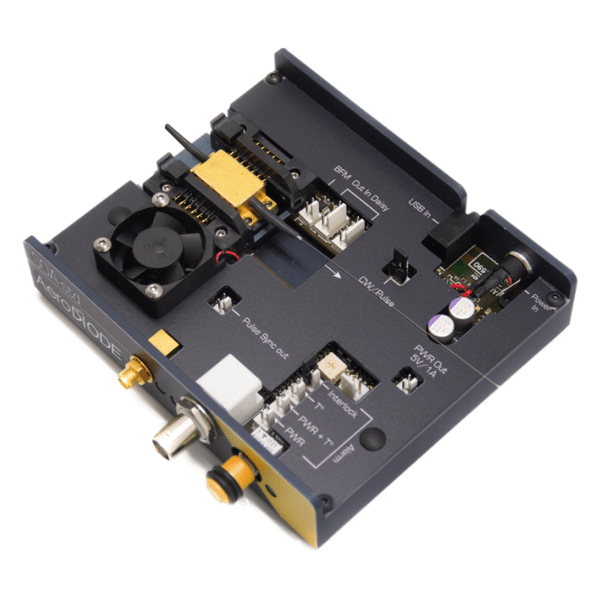
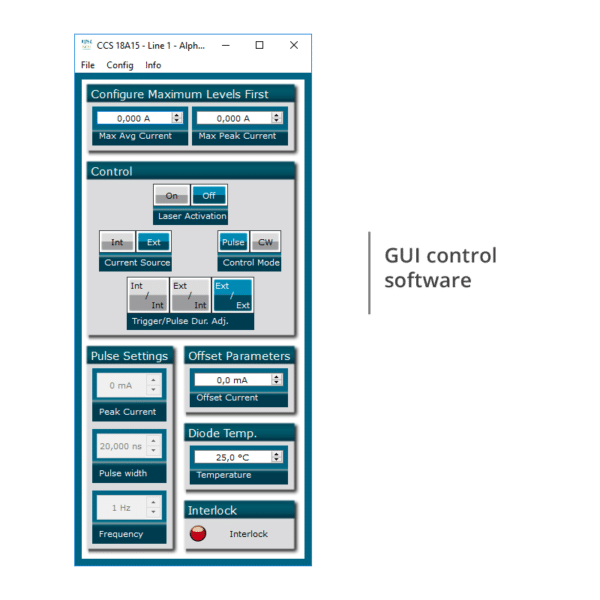
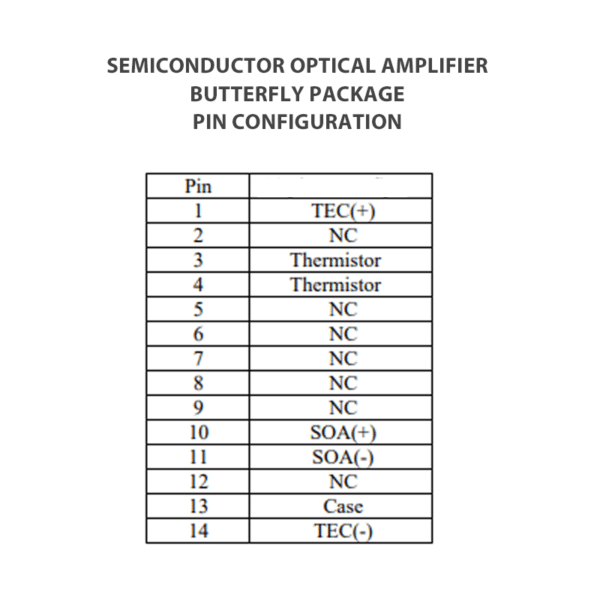
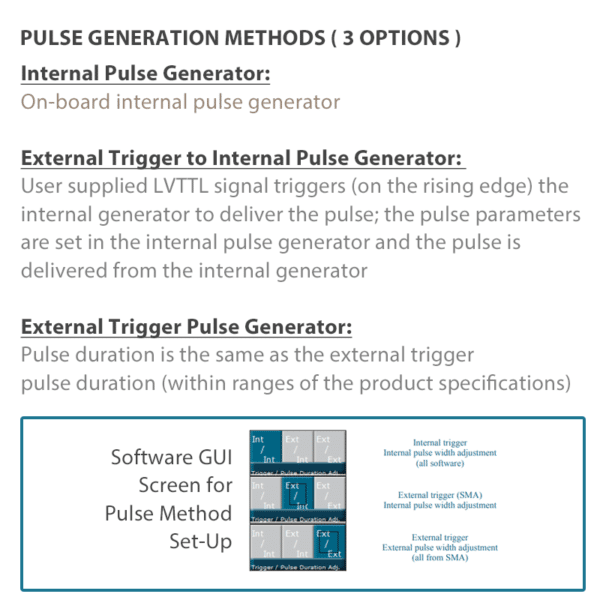
SOA Pulsed Driver Specifications
- Pulsed Output Current Range: 0 - 3500 mA
- CW Output Current CW (continuous) Mode: 0 – 1000 mA
- User Ajustable Pulse-Width Range: <1 nanosecond to CW
- Output Voltage Maximum: 4.8 Volts
- Set-point Resolution @ 500 mA: 0.1mA
- Pulse Repetition Rate Range: 1 Hz to 250 MHz
- Pulse Jitter: < 8 psec
Pulse Generation Mechanisms ( 3 Modes )
- Internal Pulse Generator: On-board pulse generator
- External Trigger to Internal Pulse Generator: User supplied LVTTL signal triggers (on the rising edge) the internal generator to deliver the pulse. The pulse parameters are set in the internal pulse generator and the pulse is delivered from the internal generator.
- External Trigger Pulse Generator: Pulse duration is the same as the external trigger pulse duration
User Interface, Power Input, Dimensions
- USB with Control Software GUI Included
- DLL Library for C programming and Hexadecimal Protocol are available at no charge
- Analog (0 – 3.3V) Remote Signal Peak Power Adjustment and Front Panel Adjustment Knob
- Input Power Supply: 12VDC (220V/110V adapter included)
- Dimensions: 146mm (W) x 130mm (L) x 37mm(H)
SOA Driver, 3.5 Amps, PULSED & CW | Semiconductor Optical Amplifier Driver | Driver + TEC Controller + Butterfly Mount
Key Features
- User Adjustable Pulse Width Range: <1 nsec to CW
- Integrated 14-Pin Butterfly Packaged Semiconductor Optical Amplifier (SOA) Mount
Shipping Information
Shipping within the USA: $155.00
International Shipments: Shipping Account Required
Offered by: AeroDIODE Corporation, a Laser Lab Source Marketplace Seller
Orders fulfilled by: Laser Lab Source in North America
Sold & Supported in North America by Laser Lab Source
Orders for this product are processed and fulfilled by Laser Lab Source, the marketplace for Laser Scientists and Engineers. This item ships from Bozeman, MT USA. It is manufactured by Aerodiode, a Laser Lab Source Marketplace Seller. Mfg Part Number: SOA-HPP
Warranty Information
This product is sold with a full one year warranty. It is warrantied to be free from defects in material and/or workmanship for a period of one year from the date of shipment. The warranty is transacted and honored by Laser Lab Source for product purchases made through Laser Lab Source.
|
Weight |
3 lbs |
|---|---|
|
Dimensions |
13 × 9 × 9 in |
|
Current Range |
1 Amp - 5 Amp |
|
Voltage Range |
1 Volt - 5 Volts |
|
Integrated Control and Mount Units |
Butterfly Units |
|
Min. Pulse Width |
1 nsec |
|
Minimum Pulse Width Range |
1 nsec - 100 nsec |
|
Form Factor |
Module (no front panel) |
|
Computer IO and Software |
GUI software included, Python Libraries, USB Available |
|
Driver Current |
3.5 A |
|
Driver Voltage |
4.8 V |
|
SOA Driver |
Pulsed SOA Drivers, CW SOA Drivers |
|
Laser Diode Drivers |
PULSED Mode |
Product Overview
Using a High Pulse Performance SOA-HPP Driver to Create a High Performance Fiber Optic Modulator
The SOA pulse driver allows the user to employ a semiconductor optical amplifier to create a high speed, high dynamic range fiber optic modulator. It is a high performance alternative to an AOM or an EOM fiber modulator. A CW laser diode is used as the input to the SOA. When the bias current driving the SOA is switched ON/OFF in a pulsed mode (with adjustable speed up to > 1 GHz), the result is a fiber optic modulator which offers multiple advantages over traditional modulator technologies. These units can be configured for wavelengths from 750 nm to 1700 nm. It is a lossless, high extinction ratio and highly polarized modulator solution.
The “SOM” Semiconductor Optical Modulator
When configured with a CW laser diode input and with and an SOA installed in the pulser, the user creates an “SOM”. SOM stands for Semiconductor Optical Modulator. Here are a few of the many advantages an SOM offers relative to an AOM, EOM or directly pulsed laser diode solution:
- The dynamic range of an SOM is higher than that of an EOM or an AOM. An AOM / EOM is typically limited to 48 dB with a high extinction ratio > ~ 50 dB
- An SOM has no polarization rotation dependencies, whereas both an EOM and an AOM typically are highly susceptible to polarization dependencies
- The spectrum of an SOM remains the same along the entire pulse, whereas when directly pulsing a laser diode, the user must consider the undesirable spectral effects which can occur from coupling of the frequency/phase spectrum and intensity profile
- The SOM is the only commercially available solution which also functions as an optical isolator for the laser input source
Type-1 Standard SOA Pin Configuration
The SOA-HPP can be ordered for any butterfly package pin configuration. Because most SOA devices are offered in Type-1 packages, SOA-HPP is pre-configured for this package type. Impedance matching is a critical factor in delivering clean high speed pulse performance. This is why the SOA-HPP unit is pre-set for your SOA’s pin configuration. Please refer to the image carousel above to view available pin settings.
Pre-Set Impedance Matching Improves your SOA’s Pulse Mode Performance.
When the impedance from the pulsed current source PCB is not properly matched to the SOA butterfly package pins, significant pulse degradation can occur. This is often seen as distortion of the SOA output pulses and/or overshoot of the pulses. The SOA-HPP unit is designed to reduce and/or eliminate this pulse degradation by matching the nominal impedance of the butterfly package with the pulse transmission line. Current sources inherently have a high output impedance and SOA’s have very low impedance. The most important requirement of proper impedance matching is matching the impedance of the load to the impedance of the transmission line. The inductance of a butterfly packaged SOA ranges from a few nanohenries to tens of nanohenries. From inductance theory, 𝑑𝑖/𝑑𝑡 is the rate of change in current over a specific period in amperes per second. The voltage increases with the inductance and with the rate of the change of the current. Energy stored in the inductor’s magnetic fields during the pulse has to be released when the pulse ends. This creates a voltage, which in turn creates a new current, which in turn creates a new magnetic field on the transmission path. This creates a “loop” which manifests as “ringing” on the pulse waveform and on other distortions to the pulse shape. The SOA-HPP current output transmission path has been carefully designed to match the current source impedance to the butterfly packaged SOA.
USB and Control Software
The user can set and monitor all of the control parameters of the laser diode using the USB input and the supplied GUI software. These units ship with the USB cable to connect your PC to the connector on the side panel. A simple to use single page menu graphical user interface allows you to control all of the pulse or CW parameters as well as set current and temperature limits. Other features of these control modules include a daisy chain output, sync output, alarm monitor and back facet monitor output to monitor the laser power.
